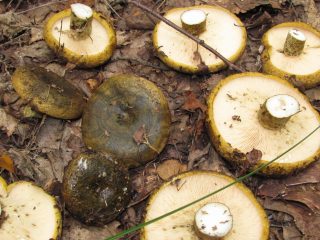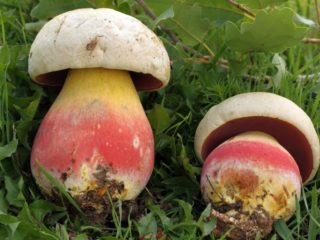Content
Bedham's dung beetle (Leucocoprinus badhami) is a lamellar mushroom from the Champignon family and the genus Leucocoprinus. Its other names:
- leucobolbitius, named by the Danish mycologist and politician Jacob Lange in 1952;
- mastocephalus is the name given to the mushroom by the Italian Giovanni Battarra in 1891.
It was first described and classified in 1888 by Narcisse Patouillard, a French pharmacist and mycologist.
Where does Bedham's white dung grow?
Badham's dung beetle is a rare species with an unusually wide distribution range. In Russia, it can be found in the foothills of the Caucasus, in Udmurtia and Tatarstan, in the southern regions and Primorye.
Feels great in hotbeds and greenhouses, on heaps of rotting garbage and humus.It is found in deciduous and coniferous forests with an abundance of windbreaks and forest litter, in gardens, parks and personal plots. Loves damp places, floodplains, damp ravines and ravines. It lives in small, closely spaced groups, rarely alone. The fruiting period is from August to November, until persistently cold weather.

This type of fruiting body loves alkaline soils rich in humus and deposits of plant remains, heated due to decay processes
What does Badham's white dung look like?
Only the newly emerged fruiting bodies have ovoid, spherical caps. As they grow, they first straighten out into a rounded dome, then transform into an umbrella with a noticeable spherical bulge at the top. Adult specimens have a prostrate shape. The edge is thin and often cracks and breaks off. The diameter of the cap ranges from 2.5-3.5 to 5-7 cm.
The surface is dry, velvety, matte. White, with small, tightly pressed scales of a brownish-rusty color, denser at the top. Color may vary to creamy grey.
The hymenophore plates in young specimens are covered with a dense cape, which with age remains on the edges of the cap and stem. They are frequent, not incremented, of even length, clearly separated from each other. White, creamy-pinkish, becoming rich red with age. The spore powder is white, yellowish or creamy, and the pores themselves are colorless.
The stem is straight or slightly curved, thin and long, with a distinct ring closer to the cap. The surface is dry, covered with white fluff up to the ring. Above – pubescent.The length varies from 3-5 to 8-11 cm, with a diameter from 0.4 to 0.9-1.7 cm. The color is white, above the ring it is brownish-beige.
The pulp is thin, fragile, watery, pure white. Has a mushroom or unpleasant putrefactive odor.

Closer to the root, the mushroom stem noticeably expands
Is it possible to eat Badham's white dung?
The fruiting body is an inedible species. There is no exact data on its toxicity; according to some sources, it contains substances hazardous to humans.
Conclusion
Badham's dung beetle is a rare, widespread species of agaric mushroom. Belongs to the Champignon family and the White Dwarf genus. Inedible, possibly toxic. It is a saprotroph and settles on rich fertile substrates and in humid lowlands. On the territory of the Russian Federation it is found in the Rostov region, Stavropol Territory, Udmurtia and Tatarstan. It can also be found in North America and Europe. The mycelium bears fruit from August to October. It grows in small groups in deciduous and coniferous forests, in parks and vegetable gardens, on rotting manure.








